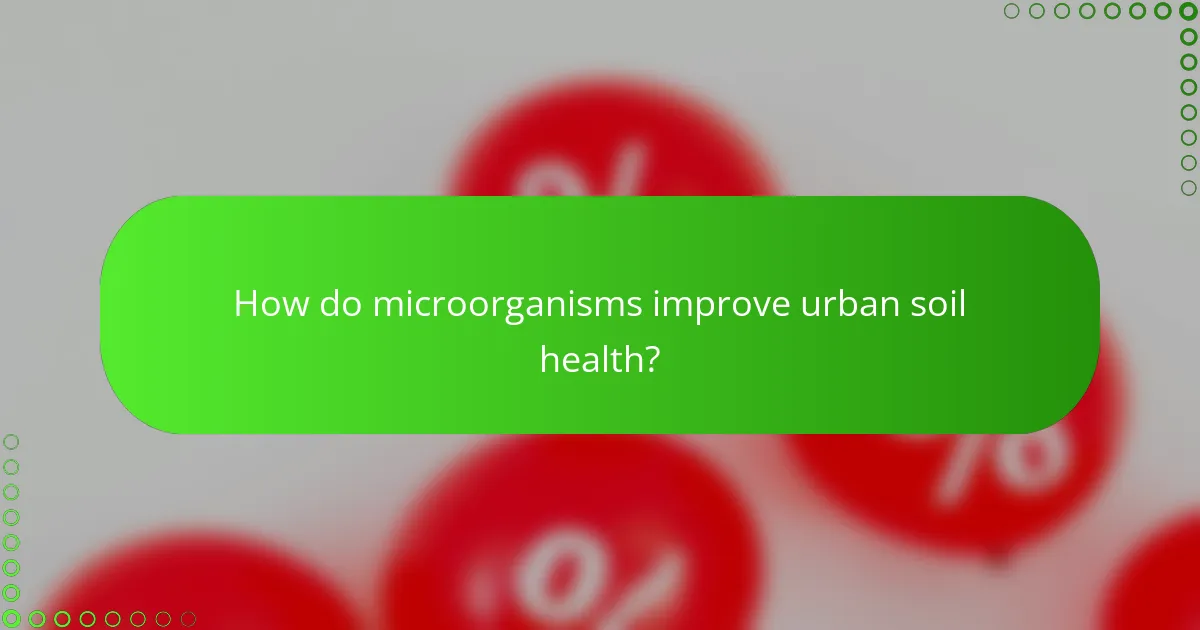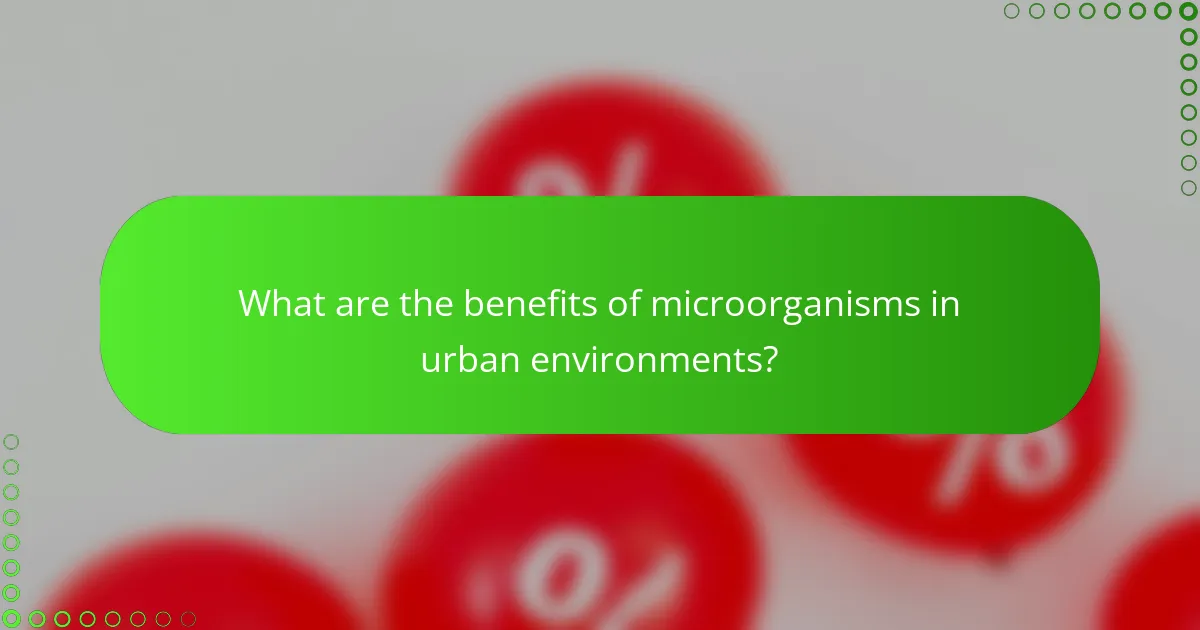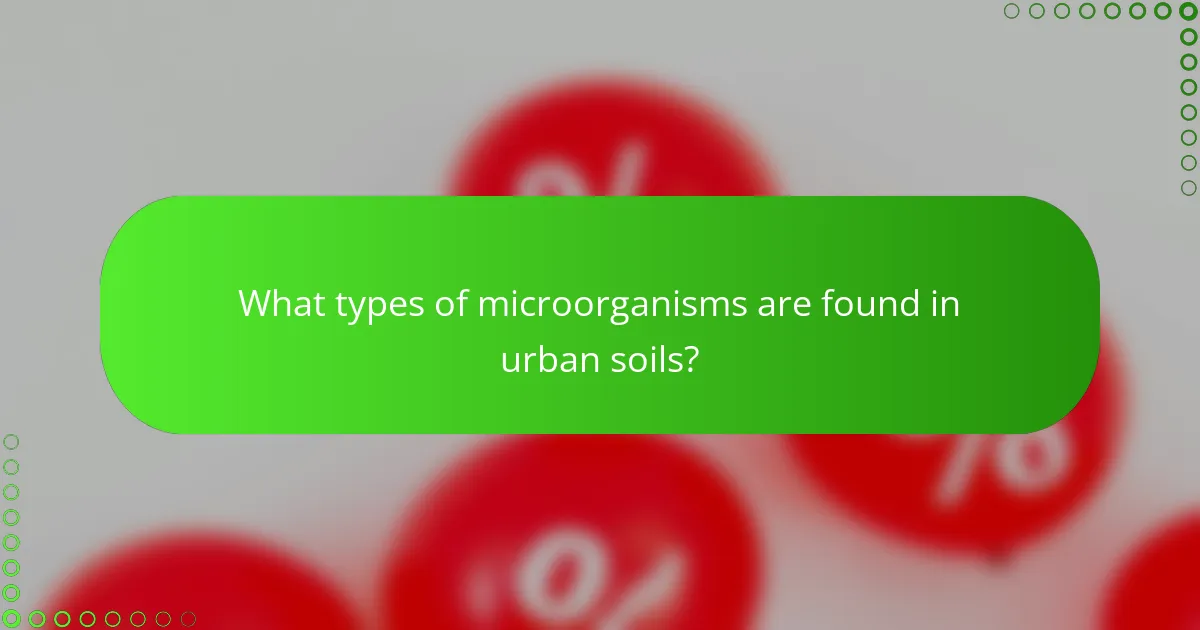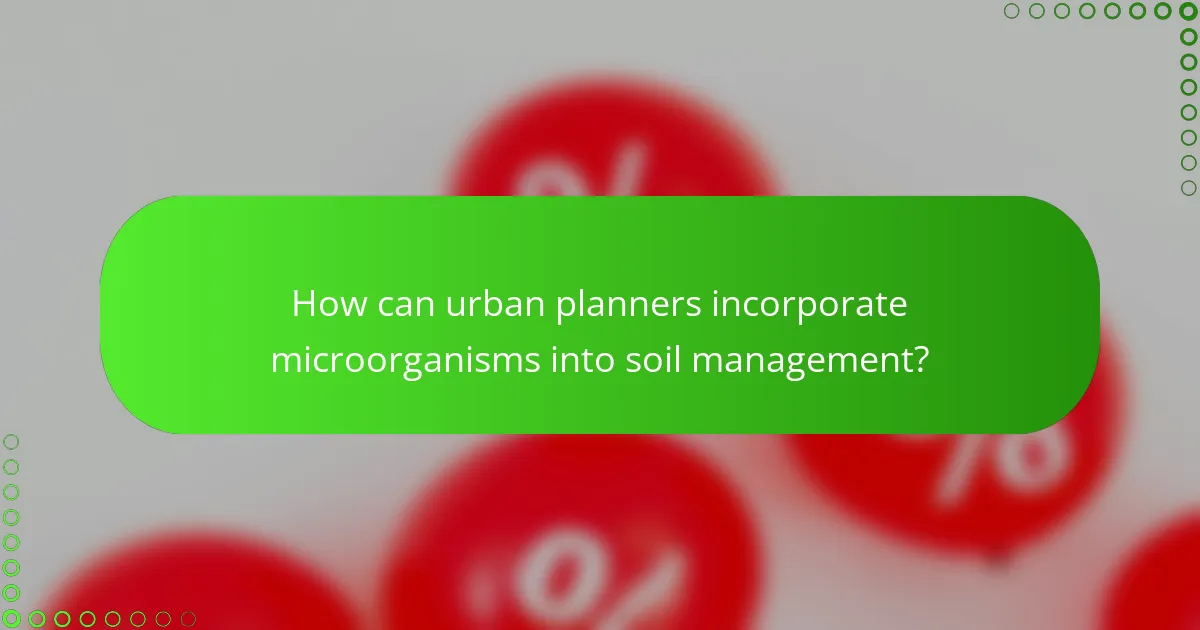Microorganisms are vital to urban soil health, as they enhance nutrient availability, improve soil structure, and maintain ecosystem balance. By supporting plant growth and mitigating pollution, these tiny organisms contribute to the sustainability and resilience of urban environments, fostering healthier landscapes for both nature and communities.

How do microorganisms improve urban soil health?
Microorganisms play a crucial role in enhancing urban soil health by facilitating essential processes that promote nutrient availability, soil structure, and overall ecosystem balance. Their activities contribute to a thriving environment for plants and other organisms, ultimately leading to healthier urban landscapes.
Enhance nutrient cycling
Microorganisms are vital for nutrient cycling in urban soils, breaking down organic matter and releasing essential nutrients like nitrogen, phosphorus, and potassium. This process ensures that plants have access to the nutrients they need for growth and development.
For effective nutrient cycling, maintaining a diverse microbial community is key. Practices such as composting and mulching can support this diversity, enhancing the soil’s nutrient profile and reducing the need for chemical fertilizers.
Increase soil structure
Microorganisms contribute to improved soil structure by producing substances like glomalin, which binds soil particles together. This enhanced structure increases porosity and aeration, allowing for better water infiltration and root penetration.
To promote beneficial soil structure, urban gardeners can incorporate organic amendments like compost or biochar. These materials not only foster microbial activity but also improve the physical properties of the soil.
Support plant growth
Healthy microbial communities directly support plant growth by enhancing nutrient uptake and providing protection against pathogens. Certain beneficial bacteria and fungi form symbiotic relationships with plant roots, increasing their ability to absorb water and nutrients.
Urban gardeners should consider using mycorrhizal fungi inoculants to boost plant health. These fungi can significantly improve root development and overall plant resilience, especially in urban environments where soil conditions may be less than ideal.
Reduce soil erosion
Microorganisms help reduce soil erosion by stabilizing soil aggregates and promoting the formation of a protective organic layer. This layer acts as a barrier against wind and water erosion, preserving valuable topsoil in urban areas.
To combat erosion, urban planners and gardeners can implement practices such as planting cover crops and maintaining ground cover. These strategies not only enhance microbial activity but also protect the soil from erosion during heavy rains or wind events.
Promote biodiversity
Microorganisms are essential for promoting biodiversity in urban soils, as they create a balanced ecosystem that supports various plant and animal species. A diverse microbial community contributes to soil health by enhancing nutrient availability and resilience against diseases.
Encouraging biodiversity can be achieved through practices like crop rotation and intercropping. These methods not only support a variety of microorganisms but also improve the overall health and productivity of urban gardens and landscapes.

What are the benefits of microorganisms in urban environments?
Microorganisms play a crucial role in enhancing urban environments by improving soil health, supporting plant growth, and mitigating pollution. Their presence contributes to sustainable urban ecosystems, making cities more resilient and environmentally friendly.
Improve water retention
Microorganisms enhance soil structure, which increases its ability to retain water. This is particularly beneficial in urban areas where impervious surfaces limit natural water absorption. Healthy microbial communities can improve soil porosity, allowing for better infiltration and reducing runoff.
For example, adding organic matter like compost can boost microbial activity, leading to improved water retention in urban gardens and green spaces. A well-aerated soil can hold significantly more moisture, which is vital during dry spells.
Reduce pollution
Microorganisms can help break down pollutants in urban soils, including heavy metals and organic contaminants. Certain bacteria and fungi have the ability to degrade harmful substances, thus cleaning up contaminated sites and improving overall soil quality.
Bioremediation techniques, which utilize these microorganisms, are increasingly being adopted in urban planning. For instance, planting specific microbial-rich plants in contaminated areas can facilitate the natural degradation of pollutants, making urban environments healthier.
Support sustainable agriculture
Microorganisms are essential for nutrient cycling, which supports sustainable agriculture in urban settings. They help decompose organic matter, releasing nutrients that plants need to thrive. This process is vital for urban farms and community gardens aiming for food security.
Urban farmers can enhance microbial diversity by incorporating cover crops and practicing crop rotation. These methods not only improve soil fertility but also reduce the need for chemical fertilizers, promoting a more sustainable approach to urban agriculture.
Enhance carbon sequestration
Microorganisms contribute to carbon sequestration by facilitating the formation of stable organic matter in the soil. This process helps capture carbon dioxide from the atmosphere, mitigating climate change effects in urban areas.
Practices such as composting and maintaining healthy soil ecosystems can significantly increase the amount of carbon stored in urban soils. By fostering microbial activity, cities can play a role in reducing their carbon footprint while enhancing overall soil health.

What types of microorganisms are found in urban soils?
Urban soils host a diverse array of microorganisms, including bacteria, fungi, protozoa, and actinomycetes. These organisms play crucial roles in nutrient cycling, soil structure, and overall soil health.
Bacteria
Bacteria are the most abundant microorganisms in urban soils, often numbering in the millions per gram. They are essential for breaking down organic matter, facilitating nutrient availability, and enhancing soil fertility.
Common types of bacteria found in urban soils include nitrogen-fixing species, which convert atmospheric nitrogen into forms usable by plants. Their activity can significantly improve soil health and plant growth.
Fungi
Fungi, including mycorrhizal fungi, form symbiotic relationships with plant roots, aiding in nutrient absorption, particularly phosphorus. They contribute to soil structure by creating networks that enhance water retention and aeration.
Urban soils may also host decomposer fungi that break down organic materials, returning nutrients to the soil. Maintaining fungal diversity is key to promoting healthy urban ecosystems.
Protozoa
Protozoa are single-celled organisms that play a vital role in the soil food web. They feed on bacteria and organic matter, helping to regulate bacterial populations and release nutrients through their waste products.
In urban soils, protozoa can indicate soil health, as their presence often correlates with a balanced microbial community. Encouraging conditions that support protozoa can enhance soil fertility.
Actinomycetes
Actinomycetes are filamentous bacteria that contribute to the decomposition of organic materials and the formation of humus. They are particularly known for their role in breaking down tough plant fibers and producing antibiotics that can suppress soil pathogens.
In urban environments, actinomycetes can improve soil health by enhancing nutrient cycling and promoting plant growth. Practices such as adding organic matter can help boost their populations in urban soils.

How can urban planners incorporate microorganisms into soil management?
Urban planners can effectively incorporate microorganisms into soil management by integrating practices that enhance soil health and biodiversity. This approach not only improves soil quality but also supports sustainable urban ecosystems.
Implement green infrastructure
Green infrastructure, such as green roofs, rain gardens, and permeable pavements, can significantly enhance urban soil health by promoting the presence of beneficial microorganisms. These systems allow for natural water filtration and reduce runoff, creating a more conducive environment for microbial activity.
When designing green infrastructure, planners should consider local climate and soil types to select appropriate vegetation and materials. Regular maintenance is essential to ensure these systems remain effective in supporting microbial life.
Promote composting practices
Encouraging composting in urban areas can enrich soil with organic matter and beneficial microorganisms. Composting not only recycles organic waste but also improves soil structure and nutrient availability, fostering a healthy microbial community.
Planners can facilitate composting by providing community compost bins or organizing workshops to educate residents on effective composting techniques. It’s important to highlight the types of materials that can be composted, such as kitchen scraps and yard waste, while avoiding contaminants like plastics.
Encourage community gardens
Community gardens serve as excellent platforms for enhancing urban soil health through the introduction of diverse plant species and microorganisms. These gardens can improve soil fertility and structure while providing educational opportunities for residents about sustainable practices.
Urban planners should support the establishment of community gardens by identifying suitable locations and providing resources such as soil testing and organic amendments. Engaging local residents in the planning process can help ensure the gardens meet community needs and promote active participation.

What are the challenges of maintaining healthy microorganisms in urban soils?
Maintaining healthy microorganisms in urban soils is challenging due to various factors that disrupt their natural balance. Key issues include pollution, soil compaction, and the introduction of invasive species, all of which can significantly affect soil health and microbial diversity.
Pollution and contamination
Urban soils often face pollution from industrial activities, heavy traffic, and improper waste disposal. Contaminants such as heavy metals, hydrocarbons, and pesticides can harm beneficial microorganisms, leading to reduced soil fertility and impaired ecosystem functions.
To mitigate pollution’s impact, urban planners and gardeners should conduct soil tests to identify contaminants. Remediation strategies, such as phytoremediation or bioremediation, can help restore soil health by using plants or microorganisms to detoxify polluted soils.
Soil compaction
Soil compaction occurs when soil particles are pressed together, reducing pore space and limiting air and water movement. This condition can be exacerbated by heavy foot traffic, construction activities, and the use of heavy machinery, which can hinder microbial activity and diversity.
To prevent soil compaction, it is essential to limit traffic on sensitive areas and utilize techniques such as aeration or the incorporation of organic matter. These practices can enhance soil structure, improve drainage, and promote a thriving microbial community.
Invasive species
Invasive plant species can disrupt the balance of urban soil ecosystems by outcompeting native plants and altering soil chemistry. These species often thrive in disturbed environments, leading to a decline in microbial diversity and function.
To combat invasive species, urban land managers should implement regular monitoring and removal strategies. Encouraging the growth of native plants can help restore the natural balance and support a healthier microbial community, ultimately benefiting urban soil health.










